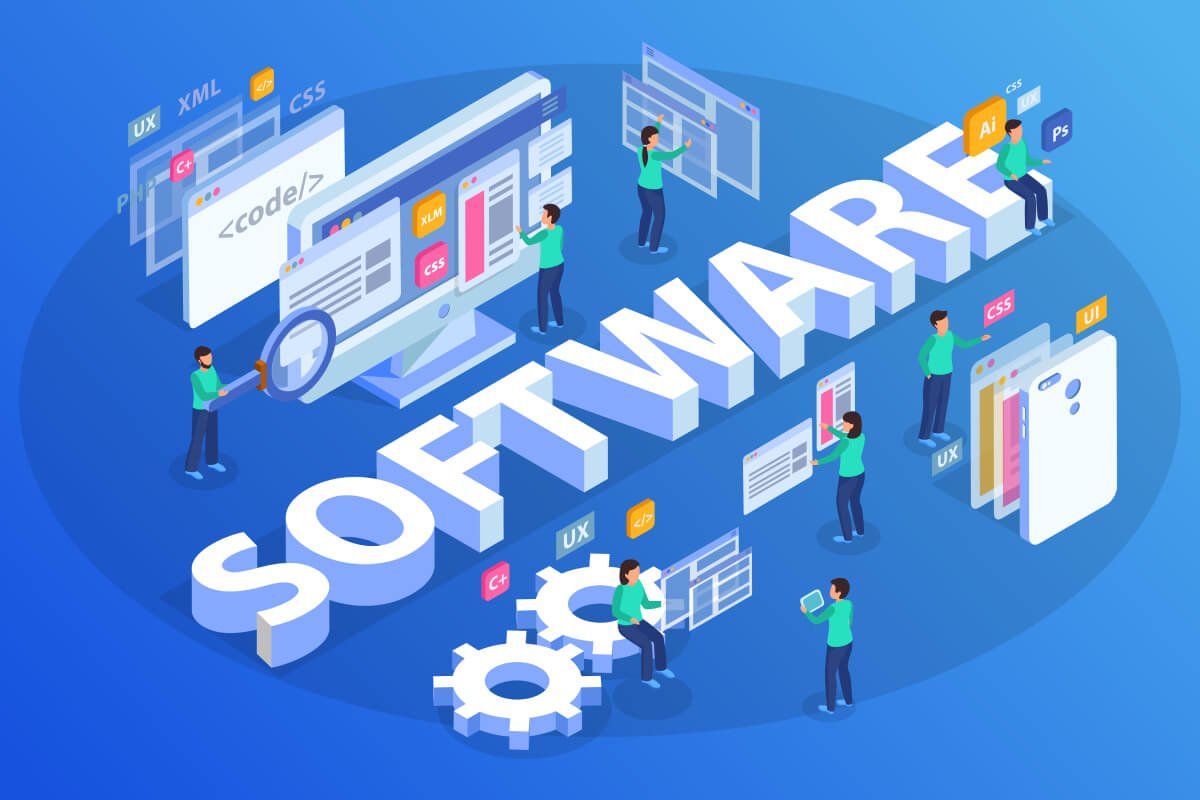The realm of software development is constantly evolving, driven by rapid technological advancements and ever-changing business demands. As we step into 2024, several transformative trends are set to redefine how software is developed and deployed. Staying ahead of these trends is crucial for businesses and developers alike to maintain a competitive edge. This blog post explores the top seven trends in software development that will dominate the industry in 2024, offering insights into the innovations shaping the future of software development. Whether you’re a seasoned developer or a tech enthusiast, understanding these trends will provide a comprehensive view of where the industry is headed.
Trend 1: Artificial Intelligence and Machine Learning Integration
Artificial Intelligence (AI) and Machine Learning (ML) have transcended the realm of buzzwords to become indispensable components of modern software development. As we move into 2024, the integration of AI and ML is set to revolutionize the way applications are developed, tested, and maintained.
Enhancing Software Development with AI and ML
AI and ML technologies are empowering developers to create smarter and more intuitive applications. These technologies analyze vast amounts of data, identify patterns, and make decisions with minimal human intervention. In software development, this translates to enhanced capabilities in various stages of the development lifecycle.
One significant application of AI in software development is predictive analytics. By analyzing historical data, AI can predict potential issues, identify trends, and provide insights that help developers make informed decisions. This predictive capability is invaluable in project planning, risk management, and resource allocation.
Automating Testing and Debugging
Testing and debugging are critical phases in software development, often consuming substantial time and resources. AI and ML are transforming these processes by automating repetitive tasks and identifying defects with high precision. AI-driven testing tools can simulate user interactions, detect anomalies, and even suggest fixes, significantly speeding up the testing phase.
Moreover, ML algorithms can learn from past bugs and errors to improve future debugging efforts. This continuous learning process ensures that the software becomes more robust and resilient over time. By automating testing and debugging, developers can focus on more complex and creative aspects of software development.
Personalizing User Experiences
In today’s competitive landscape, delivering personalized user experiences is crucial for retaining customers and enhancing satisfaction. AI and ML enable software developers to create applications that adapt to individual user preferences and behaviors. By analyzing user data, AI algorithms can offer personalized recommendations, tailor content, and optimize user interfaces.
For instance, e-commerce platforms use AI to recommend products based on a user’s browsing history and purchase behavior. Similarly, streaming services leverage ML algorithms to suggest content that aligns with a user’s viewing preferences. This level of personalization is becoming a standard expectation, and software development must evolve to meet these demands.
Conclusion
The integration of Artificial Intelligence and Machine Learning into software development is not just a trend but a necessity for staying competitive in 2024. By enhancing predictive analytics, automating testing and debugging, and personalizing user experiences, AI and ML are setting new standards for what software can achieve. Embracing these technologies will be crucial for developers aiming to create innovative, efficient, and user-centric applications.
Trend 2: Low-Code and No-Code Development
The landscape of software development is undergoing a significant transformation with the rise of low-code and no-code development platforms. These platforms are designed to simplify the development process, making it accessible to a broader audience, including those with minimal coding experience. As we move into 2024, the adoption of low-code and no-code development is set to surge, driven by the need for faster application delivery and the democratization of software creation.
Definition and Overview of Low-Code and No-Code Platforms
Low-code development platforms provide a visual approach to software development, allowing users to create applications through graphical user interfaces and pre-built modules. These platforms require some basic understanding of coding but significantly reduce the amount of manual coding needed. In contrast, no-code development platforms are even more user-friendly, enabling users to build fully functional applications without writing a single line of code. These platforms utilize drag-and-drop components and pre-configured templates, making software development intuitive and efficient.
Democratizing Software Development
One of the most significant impacts of low-code and no-code development is the democratization of software development. Traditionally, building software applications required specialized skills and extensive coding knowledge. However, with the advent of these platforms, business analysts, project managers, and other non-developers can now participate in the development process. This shift not only accelerates the development timeline but also fosters innovation by empowering a diverse group of individuals to contribute their ideas and solutions.
Use Cases and Benefits for Businesses and Non-Developers
Low-code and no-code development platforms are particularly beneficial for businesses that need to respond quickly to market changes and customer demands. Here are some key benefits:
- Faster Time-to-Market: These platforms enable rapid prototyping and deployment of applications, significantly reducing the time-to-market for new products and features.
- Cost Efficiency: By reducing the need for extensive coding, businesses can lower their development costs. Additionally, the ability for non-developers to create applications means that companies can better utilize their existing workforce.
- Flexibility and Scalability: Low-code and no-code platforms offer scalable solutions that can grow with the business. They also provide the flexibility to make changes and updates quickly without extensive rework.
- Enhanced Collaboration: These platforms facilitate better collaboration between IT and business teams, as both can work together on the same platform to create and refine applications.
- Empowerment of Citizen Developers: Non-developers, often referred to as “citizen developers,” can take charge of creating and maintaining applications that meet their specific needs, leading to more tailored and effective solutions.
Examples of Low-Code and No-Code Platforms
Some popular low-code platforms include Microsoft Power Apps, OutSystems, and Mendix, which cater to users with some coding knowledge. On the no-code front, platforms like Bubble, Adalo, and Glide are leading the way by enabling users with zero coding experience to build robust applications.
As the software development industry continues to evolve, the trend of low-code and no-code development is poised to play a crucial role in shaping the future. By making software development more accessible and efficient, these platforms are transforming how applications are built and who can build them. For businesses and individuals alike, embracing low-code and no-code development is a strategic move towards innovation and agility in 2024 and beyond.
Trend 3: DevOps and Continuous Integration/Continuous Deployment (CI/CD)
In the rapidly evolving world of software development, the adoption of DevOps practices and Continuous Integration/Continuous Deployment (CI/CD) pipelines has become a game-changer. These methodologies streamline the development process, enhancing collaboration between development and operations teams, and ensuring faster, more reliable software releases.
DevOps Practices: Enhancing Collaboration and Efficiency
DevOps is a set of practices that combines software development (Dev) and IT operations (Ops). The primary goal is to shorten the system development lifecycle and deliver high-quality software continuously. By fostering a culture of collaboration, DevOps breaks down the traditional silos between development and operations teams. This results in improved communication, faster problem-solving, and a more cohesive workflow.
Key DevOps practices include:
- Infrastructure as Code (IaC): Automating the management and provisioning of infrastructure through code, ensuring consistency and reducing errors.
- Monitoring and Logging: Continuously monitoring applications and infrastructure to detect issues early and maintain performance.
- Collaboration Tools: Using tools like Slack, Jira, and Confluence to enhance communication and project management.
CI/CD Pipelines: Automating the Path to Production
Continuous Integration (CI) and Continuous Deployment (CD) are crucial components of modern software development. CI/CD pipelines automate the process of integrating code changes, testing them, and deploying to production environments. This automation reduces the risk of human error, accelerates the release cycle, and ensures that software is always in a deployable state.
Continuous Integration (CI) involves developers frequently merging their code changes into a shared repository. Each merge triggers an automated build and test process, allowing teams to detect and address integration issues early. The benefits of CI include:
- Early Detection of Errors: Automated testing identifies bugs and integration issues as soon as they are introduced, making them easier to fix.
- Improved Code Quality: Regular integration and testing encourage developers to write cleaner, more maintainable code.
Continuous Deployment (CD) takes CI a step further by automating the release of code changes to production. This ensures that new features and fixes are delivered to users as soon as they are ready. The advantages of CD include:
- Faster Time-to-Market: Automated deployments reduce the time between development and release, enabling faster delivery of new features and updates.
- Increased Reliability: Automated processes minimize the risk of manual errors during deployment, enhancing the stability and reliability of software.
The Benefits of Adopting DevOps and CI/CD in Software Development
The integration of DevOps and CI/CD into the software development process offers numerous benefits:
- Enhanced Collaboration: By breaking down silos, DevOps fosters a culture of collaboration and shared responsibility between development and operations teams.
- Faster Releases: Automation accelerates the development and deployment cycle, enabling quicker delivery of new features and updates.
- Higher Quality Software: Continuous testing and integration ensure that code changes are thoroughly vetted, leading to more stable and reliable software.
- Improved Efficiency: Automated processes reduce manual tasks, allowing teams to focus on more strategic activities.
In conclusion, the adoption of DevOps practices and CI/CD pipelines is transforming software development. By enhancing collaboration, automating workflows, and ensuring continuous delivery of high-quality software, these methodologies are essential for staying competitive in today’s fast-paced industry. Embracing DevOps and CI/CD is not just a trend but a necessity for any organization aiming to innovate and thrive in the software development landscape of 2024.
Trend 4: Cloud-Native Development
Cloud-native development is revolutionizing the way software is built and deployed, making it a key trend to watch in 2024. As businesses continue to embrace digital transformation, the shift to cloud-native architecture is becoming essential for maintaining competitiveness and scalability. But what exactly does cloud-native development entail, and why is it gaining so much traction in the software development industry?
Overview of Cloud-Native Architecture
At its core, cloud-native development involves building and running applications that exploit the advantages of cloud computing delivery models. This approach is characterized by the use of microservices, containers, and orchestration tools like Kubernetes. Each component of a cloud-native application is designed to be independently deployable, scalable, and resilient.
Microservices break down applications into smaller, manageable services that can be developed, tested, and deployed independently. Containers provide a consistent environment for these microservices, ensuring that they run seamlessly across different computing environments. Kubernetes, an orchestration tool, automates the deployment, scaling, and management of containerized applications, further enhancing the efficiency and reliability of cloud-native development.
Advantages of Developing Cloud-Native Applications
- Scalability Cloud-native development allows applications to scale efficiently to meet varying demands. Microservices can be scaled independently, ensuring that resources are allocated where they are most needed without impacting the entire system. This scalability is crucial for businesses that experience fluctuating workloads or rapid growth.
- Flexibility By leveraging cloud-native development, organizations gain the flexibility to deploy applications across various cloud environments, whether public, private, or hybrid. This flexibility enables businesses to avoid vendor lock-in and optimize costs by choosing the best cloud solutions for their specific needs.
- Resilience Cloud-native applications are designed to be resilient and fault-tolerant. The use of containers and orchestration tools like Kubernetes ensures that applications can recover quickly from failures, with minimal downtime. This resilience is vital for maintaining service continuity and providing a seamless user experience.
- Cost-Efficiency Cloud-native development can lead to significant cost savings. By utilizing cloud resources on a pay-as-you-go basis, businesses can avoid the upfront costs associated with traditional IT infrastructure. Additionally, the efficient use of resources and automation reduces operational expenses, making cloud-native development a cost-effective solution for modern software development.
Impact on Software Development
The shift to cloud-native development is transforming the software development industry. Developers are now focusing on creating applications that are not only functional but also scalable, flexible, and resilient. This paradigm shift is driving innovation, enabling businesses to deliver better products and services to their customers.
Cloud-native development also promotes a culture of continuous improvement and agility. With the ability to deploy updates and new features rapidly, organizations can respond quickly to market changes and customer feedback. This agility is essential for staying competitive in today’s fast-paced digital landscape.
In conclusion, cloud-native development is a game-changer for the software development industry. By embracing cloud-native architecture, businesses can achieve unprecedented levels of scalability, flexibility, resilience, and cost-efficiency. As we move into 2024, cloud-native development will undoubtedly play a pivotal role in shaping the future of software development.
Trend 5: Enhanced Cybersecurity Measures
In the ever-evolving landscape of software development, cybersecurity remains a critical concern. As we move into 2024, the importance of robust cybersecurity measures cannot be overstated. With increasing cyber threats and data breaches, developers must prioritize security at every stage of the development lifecycle. Here, we delve into the emerging trends and technologies in cybersecurity that are set to shape the software development industry this year.
Importance of Cybersecurity in Software Development
The rise of sophisticated cyber-attacks has made it imperative for software developers to integrate strong security practices into their workflow. Cybersecurity is no longer an afterthought but a fundamental aspect of software development. Ensuring that applications are secure from the ground up helps protect sensitive data, maintain user trust, and comply with regulatory requirements.
Emerging Trends and Technologies in Cybersecurity
Zero Trust Architecture
One of the most significant shifts in cybersecurity is the adoption of Zero Trust Architecture. Unlike traditional security models that assume everything within an organization’s network is trustworthy, Zero Trust operates on the principle of “never trust, always verify.” This approach requires strict identity verification for every person and device trying to access resources on a private network. Implementing Zero Trust Architecture in software development enhances security by minimizing the risk of internal and external threats.
AI-Driven Security
Artificial Intelligence (AI) is playing a pivotal role in transforming cybersecurity measures. AI-driven security systems can detect and respond to threats faster than traditional methods. Machine learning algorithms analyze vast amounts of data to identify unusual patterns and potential security breaches. By integrating AI into software development, developers can create applications that automatically adapt to emerging threats, ensuring continuous protection.
Secure DevOps (DevSecOps)
The integration of security practices into the DevOps process, known as DevSecOps, is another trend gaining traction. DevSecOps emphasizes the importance of security from the outset of the software development lifecycle. This approach involves automating security checks and incorporating security tools into the CI/CD pipeline. By making security a shared responsibility among all team members, DevSecOps helps in creating secure and resilient applications.
Best Practices for Integrating Security into Software Development
To effectively integrate cybersecurity measures into software development, developers should follow these best practices:
- Shift Left Security: Implement security measures early in the development process to identify and address vulnerabilities before they become significant issues.
- Continuous Monitoring: Employ continuous monitoring and logging to detect and respond to security incidents in real-time.
- Regular Security Audits: Conduct regular security audits and vulnerability assessments to ensure that the application remains secure against new threats.
- Employee Training: Provide regular training for developers and other stakeholders on the latest security practices and threat landscape.
Conclusion
As cyber threats continue to evolve, so must the cybersecurity measures integrated into software development. By adopting trends such as Zero Trust Architecture, AI-driven security, and DevSecOps, developers can create more secure applications that protect sensitive data and maintain user trust. In 2024, enhanced cybersecurity measures will be a defining aspect of successful software development, ensuring that applications are not only innovative but also secure.
Trend 6: Edge Computing
In the ever-evolving landscape of software development, edge computing has emerged as a transformative trend that is set to revolutionize how applications are developed and deployed. Edge computing involves processing data closer to the source of data generation, rather than relying on centralized cloud servers. This approach is gaining momentum due to its ability to enhance performance, reduce latency, and improve the overall user experience.
Definition and Explanation of Edge Computing
Edge computing refers to the practice of processing data at or near the location where it is generated, rather than sending it to a centralized server for processing. This is achieved by using edge devices, such as sensors, IoT devices, and local servers, to handle data processing tasks. By bringing computation closer to the data source, edge computing minimizes the need for data to travel long distances, resulting in faster processing times and reduced latency.
In the context of software development, edge computing allows developers to create applications that can process and respond to data in real-time. This is particularly important for applications that require immediate feedback or are sensitive to latency, such as autonomous vehicles, industrial automation, and smart cities.
How Edge Computing is Transforming Software Development
The integration of edge computing into software development is transforming the industry in several ways:
- Reduced Latency: One of the most significant benefits of edge computing is the reduction in latency. By processing data locally, applications can deliver faster response times, which is crucial for real-time applications. This improvement in speed enhances the overall user experience and opens up new possibilities for interactive and immersive applications.
- Improved Reliability: Edge computing enhances the reliability of applications by reducing dependence on centralized cloud servers. In scenarios where network connectivity is unreliable or intermittent, edge devices can continue to operate and process data independently, ensuring uninterrupted service.
- Enhanced Security and Privacy: With edge computing, sensitive data can be processed locally, reducing the need to transmit it over the internet. This minimizes the risk of data breaches and enhances privacy. Additionally, edge computing can support advanced security measures, such as real-time threat detection and mitigation, at the edge of the network.
- Cost Efficiency: By offloading data processing tasks to edge devices, businesses can reduce the load on centralized cloud servers and minimize data transfer costs. This can result in significant cost savings, particularly for applications that generate large volumes of data.
- Scalability and Flexibility: Edge computing provides a scalable and flexible architecture that can adapt to the needs of various applications. Developers can deploy edge devices as needed, allowing for incremental scaling and efficient resource utilization.
Benefits of Edge Computing for Latency-Sensitive and Real-Time Applications
Edge computing is particularly beneficial for latency-sensitive and real-time applications. For example, in the case of autonomous vehicles, real-time data processing is critical for making split-second decisions. Edge computing enables these vehicles to process sensor data locally, ensuring rapid response times and enhancing safety.
Similarly, in industrial automation, edge computing allows for real-time monitoring and control of machinery, reducing downtime and improving operational efficiency. Smart cities can leverage edge computing to manage traffic flow, monitor environmental conditions, and enhance public safety through real-time data analysis.
As software development continues to evolve, edge computing is poised to play a pivotal role in shaping the future of the industry. By bringing computation closer to the data source, edge computing enables faster, more reliable, and secure applications, meeting the growing demand for real-time and latency-sensitive solutions. Embracing this trend will allow developers to unlock new possibilities and create innovative applications that deliver exceptional user experiences.
Trend 7: Progressive Web Apps (PWAs)
As the landscape of software development continues to evolve, Progressive Web Apps (PWAs) have emerged as a transformative trend in 2024. PWAs combine the best features of web and mobile applications, offering a seamless user experience that bridges the gap between traditional web apps and native mobile apps. This innovative approach to software development is gaining traction for its numerous benefits and enhanced performance.
What are Progressive Web Apps?
Progressive Web Apps are web applications designed to provide a native app-like experience while leveraging the accessibility of the web. Unlike traditional web apps, PWAs can be installed on a user’s device, work offline, and provide push notifications, mimicking the functionality of native apps. They are built using standard web technologies like HTML, CSS, and JavaScript, but they include additional features that enhance user engagement and performance.
Benefits of PWAs in Software Development
- Improved Performance: PWAs are designed to be fast and responsive, even on slower networks. They use service workers to cache assets and data, allowing the app to load quickly and function offline. This improves the overall user experience and reduces bounce rates.
- Cross-Platform Compatibility: One of the key advantages of PWAs is their ability to work across various platforms and devices. Whether users are on a desktop, tablet, or smartphone, they can access the same application with a consistent experience. This reduces the need for separate development for different platforms, streamlining the software development process.
- Enhanced User Engagement: PWAs offer features such as push notifications, which can help re-engage users and keep them informed about updates or new content. This capability is especially useful for businesses looking to maintain user interest and drive repeat interactions.
- Cost-Effectiveness: Developing a PWA can be more cost-effective than creating separate native apps for different platforms. By focusing on a single codebase that works across all devices, developers can save time and resources, making PWAs an attractive option for many businesses.
- SEO Benefits: PWAs are indexed by search engines just like traditional web pages, providing SEO benefits that can enhance visibility and drive traffic to the application. This can lead to higher user acquisition and improved search rankings.
Examples of Successful PWAs
Several companies have successfully implemented PWAs to enhance their software development efforts. For instance, Twitter’s PWA, Twitter Lite, offers a streamlined experience with faster load times and offline access, resulting in increased engagement and user retention. Similarly, Pinterest’s PWA has improved performance and user experience, contributing to significant growth in engagement metrics.
Conclusion
Progressive Web Apps represent a significant trend in software development for 2024, offering a powerful combination of web and mobile app features. By leveraging the advantages of PWAs, businesses can deliver faster, more engaging, and cost-effective applications that meet the evolving needs of users. As the demand for seamless and performant applications continues to grow, adopting PWAs can provide a competitive edge and drive success in the ever-changing landscape of software development.
Conclusion
As we navigate through 2024, it’s clear that software development is experiencing a transformative shift driven by several key trends. From the integration of Artificial Intelligence and Machine Learning to the rise of low-code and no-code platforms, these advancements are reshaping how we approach software development. Embracing these trends is not just about staying current; it’s about leveraging innovative technologies to enhance efficiency, security, and user experience in software development.
The adoption of DevOps practices and CI/CD pipelines is streamlining workflows and accelerating deployment cycles, while cloud-native development is offering unprecedented scalability and flexibility. Enhanced cybersecurity measures are crucial for safeguarding applications, and edge computing is addressing the need for low-latency processing. Progressive Web Apps are pushing the boundaries of web and mobile experiences, making software development more dynamic than ever.
Staying informed about these trends will empower developers and businesses to adapt and thrive in the evolving landscape of software development. By integrating these trends into your projects, you’ll not only keep pace with industry changes but also drive innovation and achieve greater success in your software development endeavors.













